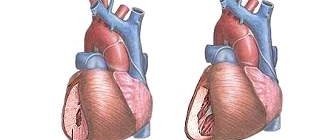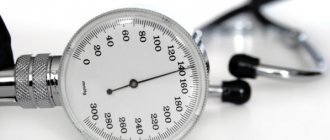- Gallery
- Reviews
- Articles
- Licenses
- Vacancies
- Insurance partners
- Partners
- Controlling organizations
- Schedule for receiving citizens for personal requests
- Online consultation with a doctor
- Documentation
Increased intracranial pressure occurs with an increase in the volume of brain tissue, cerebrospinal fluid, or a voluminous pathological process in a relatively closed cranial cavity.
You need to imagine that the head is, first of all, the tightly connected bones of the skull, inside which the brain is located. And naturally, an increase in internal volume increases pressure on the bones of the skull and, accordingly, on the tissues and vessels of the brain.
The accumulation of cerebrospinal fluid (CSF) in the cranial cavity is called hydrocephalus. It can be either external, i.e. accumulation of cerebrospinal fluid around the brain and internally (enlarged cerebral ventricles). This pathology can occur at any age - from newborns to the elderly. Each age interval has its own causes, there are age-related characteristics of manifestations and age-related characteristics of treatment.
What is increased intracranial pressure?
Inside the brain there is a system of interconnected ventricles, which are also filled with cerebrospinal fluid (CSF). This protects the human brain from injuries, concussions, as much as possible. The pressure of cerebrospinal fluid on brain structures is called intracranial pressure. Exceeding the permissible norms entails a number of consequences.
The main question for parents is what are the signs of intracranial pressure in a child, and what threat does this pose to the child?
What complications can there be in children? If left untreated, increased intracranial pressure can lead to the following consequences: the occurrence of epileptic syndrome, blurred vision, mental disorders, strokes, disorders of consciousness, breathing problems, weakness in the limbs, etc.
What should parents of a child with this diagnosis know? ICP is not a disease, but only a symptom, a consequence of various diseases. There are several misconceptions among parents regarding increased intracranial pressure. For example, the fact that this is an incurable condition. However, with timely treatment, the child’s recovery is possible. The main thing that needs to be done is to consult a specialist in time and follow the doctor’s instructions.
Diagnostic methods
It is impossible to measure intracranial pressure at home. The only thing a patient can do to help himself is to detect the symptoms in time and consult a doctor for a detailed diagnosis. It is worth understanding that the procedures for measuring ICP are complex and require special equipment and sufficiently qualified medical personnel. All these conditions are available at the Clinical Institute of the Brain, which specializes in the diagnosis and treatment of pathologies of nervous activity.
The only way to accurately determine intracranial pressure is to puncture the cerebrospinal fluid. The technique is invasive and is used only in complex cases. To do this, it is necessary to make a puncture in the lumbar region (into the spinal cord canal) or the ventricles of the brain. The cerebrospinal fluid that is constantly circulating in these spaces will begin to flow out, and its pressure can be measured. The value is measured in mm of water column, and its norm is from 60 to 200 mm. These data are indicative if the patient is in a supine position.
There are also additional diagnostic techniques that allow you to assess the condition of the brain, its ventricles and vascular bed without invasive intervention. These include:
- Ultrasound of the brain - the procedure is performed only for children who have not had fusion of the fontanelle, and in adults it is impossible due to the density of the bones of the skull;
- CT or MRI of the brain - analysis can be done at any age, while the data is quite informative and allows you to obtain a complete three-dimensional image of any area under study;
- echoencephalography is a type of ultrasound examination that can be used to determine the degree of filling and pulsation of the cerebral arteries.
It is impossible to diagnose increased intracranial pressure based on the clinical picture alone. However, all this data must be provided to the doctor during the initial examination. Based on them, specialists from the Clinical Institute of the Brain will prescribe all the necessary diagnostic stages, which will allow a full assessment of the patient’s condition.
Symptoms of increased intracranial pressure
Increased intracranial pressure in children, symptoms of which can appear in the first minutes and hours after birth, often leads to the development of serious complications.
When parents may suspect something is wrong:
In young children:
- The baby constantly cries and does not calm down;
- Lack of thirst in the child, reluctance to drink;
- The baby is irritated by bright lights and sharp sounds;
- The child burps frequently and profusely;
- The baby's fontanel bulges;
- The baby's chin is shaking;
- Rapid head growth (this is due to stagnation of venous blood);
- The child throws his head back.
In older children
- Severe headaches;
- Nausea, vomiting;
- Increased fatigue, weakness;
- Drowsiness;
- Tearfulness, irritability;
- Apathy;
- Double vision.
Knowing the key signs of the disease, you can establish the correct diagnosis in the early stages and prescribe the correct treatment for your child. Even if you have only one of the listed symptoms, you need to immediately contact a neurologist! The sooner your baby receives help, the fewer consequences it will have for the child’s body in the future.
Reasons for the development of the disorder
The factor that provokes an increase in pressure is the impaired outflow of cerebrospinal fluid from the brain. Normally, it occupies about 10% of its total volume, performing various functions, which include:
- protection of the brain from trauma - in the event of an impact or fall, the cerebrospinal fluid will “soften” the contact of the cranial bones and delicate tissues;
- it is also with the movement of cerebrospinal fluid that toxins and decay products are removed from the brain;
- Finally, it ensures that the correct electrolyte-water balance is maintained.
The most common causes of ICP include metabolic disorders that provoke insufficient flow of fluid into the blood, as well as spasm of the vessels through which the cerebrospinal fluid moves. In addition, oxygen deprivation of the brain, excess fluid in the body, obesity, severe intoxication, and inflammation of the brain can also provoke ICP. The presence of tumors in the body - benign or malignant - can also cause disruption of the outflow of cerebrospinal fluid.
If the outflow of cerebrospinal fluid from the intracranial space is disrupted for any reason, this provokes the accumulation of its excess volume and an increase in pressure. At the same time, in both a child and an adult patient, an increase in intracranial pressure to more than 30 mm Hg can lead to the development of irreversible changes in tissues and, as a consequence, disability and even death.
Diagnosis of intracranial pressure
Before prescribing treatment for your child, we perform a comprehensive neurological examination. It includes:
- Collecting anamnesis (conversation with the mother, studying the child’s medical record, history of pregnancy and childbirth and the results of previous studies);
- special neurological tests;
- active and muscle tests;
- reflex diagnostics;
- local palpation examination of the spine and musculoskeletal system.
In addition to the main examination, if necessary, the doctor may prescribe:
- NSG (neurosonography, ultrasound of the brain);
- MRI;
- Ultrasound;
- X-ray;
- Lab tests;
- EEG;
Diagnostics
It is extremely difficult to suspect an increase in ICP based on external signs.
The doctor must know all the complaints and those facts from life that preceded the symptoms. This could be a hypertensive crisis, head injury, severe infection, kidney or liver problems. In order to confirm the diagnosis, the doctor will prescribe a number of studies to the patient: CT or MRI of the brain to evaluate the structure of all tissues of the skull, note the condition of the ventricles of the brain where cerebrospinal fluid accumulates;
- echoencephaloscopy to determine brain function;
- Ultrasound of the brain (mainly in children through the fontanelle);
- examination of the condition of the fundus by an ophthalmologist;
- spinal cord puncture with measurement of the pressure of the escaping cerebrospinal fluid (the cerebrospinal fluid itself is taken for analysis).
Treatment of intracranial pressure
To treat our little patients, we use only painless, gentle treatment methods that do not cause discomfort to the baby.
We use methods:
- Transcranial micropolarization (TCMP) is the effect of a low-power direct electric current (less than 1 mA) on brain tissue in order to activate individual brain centers (speech, motor, psychomotor, etc.);
- Manual therapy;
- Osteopathy - treatment by the hands of a doctor, a gentle effect on the musculoskeletal system, nervous and vascular systems, internal organs;
- Acupuncture - exposure to biologically active points with microneedles;
- Pharmacopuncture - the introduction of medicinal drugs of natural origin to the source of the problem;
- Isometric kinesiotherapy - individual gymnastic techniques/exercises, according to indications, with elements of joint massage;
- Isometric kinesiotherapy using the Exart installation;
- Ozone therapy - treatment with active oxygen;
- Physiotherapy;
- Physiotherapy with enzyme preparations;
- Medical massage;
- Therapeutic droppers;
- Hirudotherapy - treatment with leeches;
- Botulinum therapy - treatment with botulinum toxin;
- Tsubotherapy is a gentle effect on the reflex points of the body.
Remember that with increased intracranial pressure in children, treatment should be comprehensive, individual and under the supervision of a doctor.
Prevention of intracranial pressure in adults at home
Prevention of increased ICP is the prevention of various diseases affecting the cranial cavity.
This includes protection against infections that can affect the brain - vaccination against meningococcal and hemophilus influenzae infections, influenza vaccination. It is also necessary to treat various pathologies that can affect brain function. General recommendations are simple:
- follow a daily routine and lead the healthiest lifestyle possible;
- avoid head injuries;
- protect yourself from stress and nervous overload;
- Get enough sleep.
Diseases caused by increased intracranial pressure
Our pediatric neurology department will help you not only make a correct diagnosis, but also undergo a course of treatment if your child has:
- Hyperactivity (attention deficit hyperactivity disorder, ADHD);
- Cerebral palsy (cerebral palsy);
- Autism;
- Delayed psychomotor development;
- Delayed speech development;
- Speech defects;
- Stuttering;
- Nervous tics;
- Enuresis;
- Sleep disturbances (sleeps poorly, sleeps little, wakes up frequently, does not fall asleep for a long time);
- Hypertonicity;
- Pyramid syndrome (pyramidal insufficiency syndrome);
- Hypertensive syndrome;
- Hydrocephalus (hydrocephalic syndrome, dropsy of the brain);
- Perinatal encephalopathy (perinatal damage to the central nervous system, PEP, PPCNS);
- Minimal brain dysfunction (MCD).
Causes of intracranial pressure:
- Birth or traumatic brain injury;
- Prematurity, pathologies during pregnancy or childbirth;
- Untimely fusion of the skull bones in a child;
- Benign brain tumors, which lead to increased blood pressure and changes in brain structures;
- Malignant brain tumors;
- Meningitis;
- Encephalitis;
- Toxic cerebral edema;
- Hydrocephalus;
- Genetic abnormalities and defects of the cerebrospinal fluid tract;
- Traumatic brain injury;
- Intracerebral hemorrhage.
Why does pressure in the cranium increase?
The causes of increased intracranial pressure (ICP) in adolescents are slightly different from those in adults. This is often observed during puberty from 15 to 17 years of age, when hormonal changes in the young body intensively occur. In addition, this condition often occurs with severe emotional overload, stress, autoimmune diseases and neurocirculatory dystonia.
Increased production of cerebrospinal fluid and disruption of its outflow from brain structures may indicate very serious pathological processes that occur in the child’s brain:
- inflammatory processes in the spinal cord and brain with meningitis or encephalitis;
- traumatic brain injuries;
- formations in the brain;
- history of birth injuries;
- hypoxia in drug poisoning.
With a gradual increase in intracranial pressure, the child may not present any complaints for a long time, as compensatory mechanisms are activated that normalize the functioning of the central nervous system.









